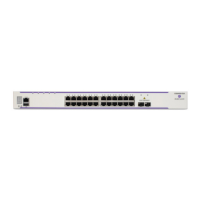Show Commands
Page 424 7750 SR OS Basic System Configuration Guide
System Ref. ID
IP address of this node or a 4-character ASCII code showing the state.
Auth Error
Displays the number of authentication errors.
Auth Errors
Ignored
Displays the number of authentication errors ignored.
Auth key ID Errors
Displays the number of key identification errors .
Auth Key Type
Errors
Displays the number of authentication key type errors.
Reject
The peer is rejected and will not be used for synchronization. Rejection
reasons could be the peer is unreachable, the peer is synchronized to
this local server so synchronizing with it would create a sync loop, or
the synchronization distance is too large. This is the normal startup
state.
Invalid
The peer is not maintaining an accurate clock. This peer will not be
used for synchronization.
Excess
The peer's synchronization distance is greater than ten other peers.
This peer will not be used for synchronization.
Outlyer
The peer is discarded as an outlyer. This peer will not be used for syn-
chronization.
Candidate
The peer is accepted as a possible source of synchronization.
Selected
The peer is an acceptable source of synchronization, but its synchroni-
zation distance is greater than six other peers.
Chosen
The peer is chosen as the source of synchronization.
ChosenPPS
The peer is chosen as the source of synchronization, but the actual syn-
chronization is occurring from a pulse-per-second (PPS) signal.
Remote
The IP address of the remote NTP server or peer with which this local
host is exchanging NTP packets.
Reference ID
When stratum is between 0 and 15 this field shows the IP address of
the remote NTP server or peer with which the remote is exchanging
NTP packets. For reference clocks, this field shows the identification
assigned to the clock, such as, “.GPS.” For an NTP server or peer, if
the client has not yet synchronized to a server/peer, the status cannot be
determined and displays the following codes:
Label Description (Continued)

